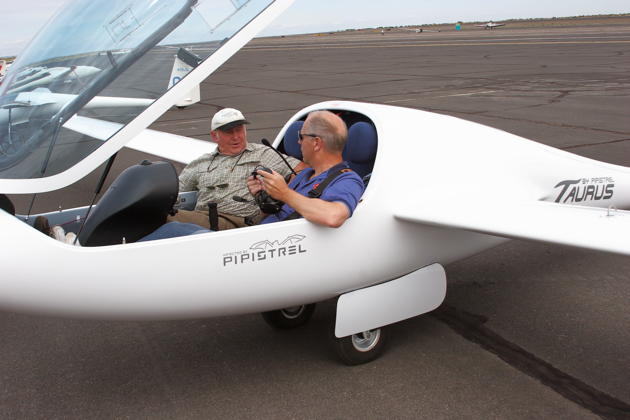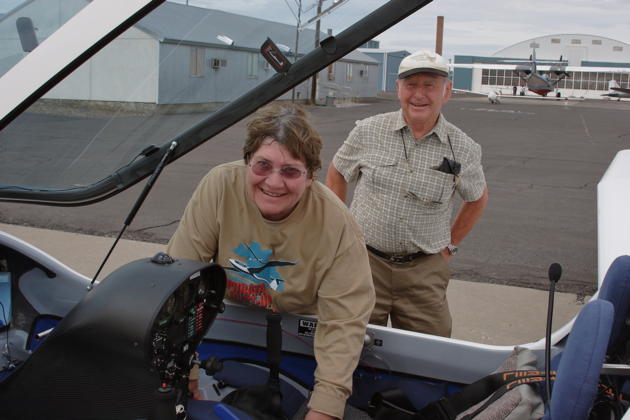FlightLog Archive
∟Aircraft Flown
Soaring in the Pipistrel Taurus - May 2010
As I arrived at Ephrata, WA for the start of the 2010 Dustup soaring competition, I was introduced to some of the competitors who had been regulars at Ephrata many years ago. One of the first arrivals on Friday afternoon was Peter Timm and his wife Christine, who had traveled from Pemberton, British Columbia. Peter Timm has long flown from the Pemberton Soaring Centre in British Columbia, and has owned a Phoebus and an HpH 304CZ sailplane, and also built a Europa monowheel touring aircraft. At Ephrata, Peter was proud to be flying his new Pipistrel Taurus, a lightweight side-by-side self-launching sailplane. Peter's is the 43rd Taurus built.
The Taurus is an intriguing new design by the Pipistrel team from Slovenia, using a similar wing design from their Apis sailplane and Sinus motorglider. The Taurus, due to the extensive use of carbon fiber construction, is a very lightweight design that fits within the Light Sport category. Even with a self-launching engine and a ballistic parachute system, its empty weight is only an amazing 615 pounds! Unique design elements include: a Rotax 503 retractable engine and propeller, 41:1 glide ratio, retractable dual main landing gear, a rocket-powered ballistic recovery system and side-by-side seating.
The weather for our 2010 Ephrata Dustup competition was very disappointing, allowing only one competition day, with only five finishers. Peter Timm, however, enlivened the week for a few of us by offering demonstration flights in his Taurus. Heinz Gehlhaar and Chris Klix enjoyed flights while I was up in the DG-1000, and Peter kindly offered me a flight later in the afternoon.
After Chris landed, Peter had me jump in and began going over the cockpit layout and engine start procedures. We buckled in and donned our headsets, and I was impressed by the ample width and headroom, even for my 6' 1" height. The Rotax 503 engine was already warm from the previous flight, so we cranked easily after raising the propeller and began taxiing right after the easy startup. The dual main gear and steerable tailwheel design allows 'normal aircraft' taxi, and is a wonderful feature for operations without wing runners.
Peter completed a run-up check and we ran the Rotax up and began a relatively short takeoff run. We started our climb, adjusted our flap setting and settled into a stable climb at between 700 and 800 feet per minute, which was impressive given our combined weights. Peter had me hold about 53 knots in the climb, which corresponded to a light blue mark on the airspeed indicator. Visibility was outstanding. The vibration from the Rotax 503 was a bit more than I expected from my experience with the engine in the ASH-25 Mi, and combined with blanking of the Total Energy probe, it had a quite noticeable effect on the variometers, which bounced from +100 to +800 FPM and made them almost unusable in the climbout.
Peter was trying to avoid siphoning too much fuel from the gas tank for his drive back to Pemberton, so I gladly climbed under power to 6000 feet, outclimbing an adjacent sailplane under tow. We reduced the throttle for a short time to cool the engine, then shut it down and quickly stowed it, removing and stowing our headsets in the process. I could watch the retraction process easily through a mirror mounted under the front canopy bow.
We were now in pure sailplane mode, having retracted the dual main landing gear earlier in the climb. I was able to find some decent thermals and enjoy the tight thermaling capability provided by the 15-meter wings, thermaling in the 45-50 knot range. I had been flying so much recently in the long winged 20-meter DG-1000 that I felt like I was back in a 1-26 again, able to turn tightly and maintain a climb in the small thermals. Peter described the trim system as one of his least favorite features of the Taurus, but with minor trim adjustments I was able to provide for very light stick forces through the thermaling and cruise speed ranges, after also adjusting flaps for thermaling or cruise.
I didn't have any issues with sitting off the centerline, especially after noting the index mark that was added above the yaw string on the canopy, showing the 'centered' position. Peter noted that he liked to fly as pilot-in-command from the right seat, since the gear, flap, trim and spoiler handles were all located in the center console. As we descended down to pattern altitude, it was very easy to keep nearby sailplanes in view, even looking 'cross-cockpit'. I tried flying with my left hand on the stick while descending on final, and used my right hand for spoiler control. The spoilers are effective, and I agree with Peter that the optimum pilot-in-command location would be from the right seat, allowing a more normal stick grip and spoiler feel. After touchdown, the steerable tailwheel allowed us to roll right into our preferred location.
The Pipistrel Taurus offers a great design that provides for great handling on the ground with no support staff, allows for self-launch and a good climb rate, then cleans up to become a good soaring platform, both for training and for personal touring. Thanks, Peter, for the opportunity to fly your excellent self-launching sailplane. I'll have to come up to beautiful British Columbia and fly her again on her home turf!
 KASPRZYK
KASPRZYK







